Arctic social science: Q-and-A with Diane Hirshberg
by Kathleen McCoy |
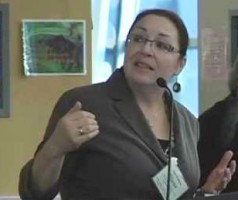
Diane Hirshberg, professor of education policy and director of the Center for Alaska Education Policy Research, helped chair two Arctic research events at UAA last week. Both focused on sustainable human development-how residents can manage to thrive despite great social, climate and financial upheaval in their communities.
On Sept. 18-19, UAA hosted two events that brought together social science scholars from across the globe to focus their expertise on one question: How can Arctic peoples survive and thrive in a time of rapid environmental and economic change in their region?
Contemporary discussions about the Arctic are often around potential shipping routes, the science of global warming and the potential it creates for easier resource extraction.
In contrast, these two events presented work on human resilience and adaptation. The two-day conference, called Arctic-FROST, is part of a multi-year effort to answer the question: What does sustainability mean to the Arctic community?
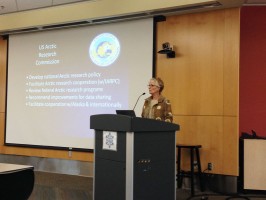
Fran Ulmer, chair of the U.S. Arctic Research Commission, addressed the Arctic-FROST conference, describing that agency's research agenda. (Photo by Diane Hirshberg/UAA)
The National Science Foundation awarded the University of Northern Iowa $749,875 to support Arctic-FROST for five years. Anchorage hosted its inaugural event and UAA's Dr. Diane Hirshberg and Dr. Douglas Causey facilitated sessions in collaboration with UNI's Dr. Andrey Petrov. A steering committee for the group includes representatives from Russia, Canada, Sweden, Denmark, Iceland and the United States.
The second event was a Friday evening "sneak preview" to an update of the Arctic Human Development Report, first written a decade ago. A podcast of the presentations can be found on the UAA podcast page. Alaska Public Media news interviews with Diane Hirshberg and Andrey Petrov regarding the two Arctic events are available on their website.
Seawolf Weekly invited Diane Hirshberg to put these Arctic discussions in context for a broad audience.
What does human development mean?
We are talking about the ability of humans to thrive and move forward. There are all sorts of pieces to it, including human capital development, which is what you get through some kind of formal training or education. We are also talking about moving people forward in terms of wellness and health, cultural wellbeing, language.
In the Arctic Human Development Report (AHDR), we are talking about everything from economic wellbeing to physical health...and not necessarily assuming the model of the West or the model of one particular culture is more appropriate than another model. So indigenous voices are really strong in this.
Where are the conflicts?
In a lot of resource development in the north, there tends to be detriments where you think there would be benefits. There is the concept of the 'resource curse,' where there are communities that have new wealth and new connections to corporate and multinational entities. Yet things are not going well in those communities. There are all sorts of issues, including high suicide rates, even though there is resource development.
You see those tensions where the control of the resources is not necessarily residing with the people who have lived on the land for thousands of years. So suddenly they need to deal with these external entities. There are unintended consequences, whether it is environmental disruption that interferes with subsistence livelihoods or disruptions to humans that affect your ability to continue practicing your traditional spiritual beliefs, maintaining your language and such.
The North Slope Borough is an interesting place for that. The population is certainly hugely changed since oil came in. There has been a lot of wealth there and investment in facilities, yet there are also problems with substance abuse and poverty.
Greenland is on the verge of huge mineral discoveries as climate change makes mineral deposits accessible. But it also makes it dangerous for hunters who can't go out on the ice to get seals and other things.
Greenland is just entering this; they are right at the tipping point that other countries have already gone through.
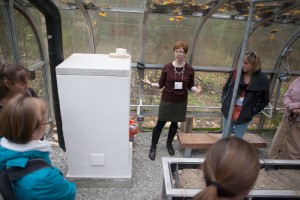
Jennifer Brock, a mechanical engineering professor at UAA, introduces a student-built masonry heater to Arctic-FROST conference attendees. An old technology in Europe, this fast-flame combustion heater circulates warm air in channels within the brick structure. This year students are continuing to design it for use in rural Alaska. (Photo by Philip Hall/University of Alaska Anchorage)
You mentioned the role of indigenous people and scholars in this question of sustainability. Tell me more.
What we are seeing is a very intentional move toward growing the presence of indigenous people in the academy. And the recognition that comes with it, that indigenous research methods are a very important set of research methods to incorporate into what we are doing. Most of us, when we were trained, had a very western focus that is about a certain definition of the term empirical research, a certain notion of what science is, whose knowledge is validated and in what ways.
Now we begin to see people walking in who also have a doctorate who begin to say there is a different way that we can do this research. There is now an understanding of the importance of privileging multiple ways of exploring these issues, multiple knowledge sets. It needs to be a partnership.
Will you develop a definition of sustainability that applies specifically to the Arctic?
There is no agreed upon definition of sustainability. That is part of what this first meeting is about. We are starting to develop a commonly shared definition of sustainability, and then moving toward how we study it.
Arctic-FROST is a research collaboration network, so it is not about creating new knowledge. It is about bringing together scholars in an interdisciplinary way to share what we are doing. And then toward the end of this project comes the education point: How do we get this out to universities, to K-12, so that we are creating a new generation of Arctic scientists.
Education is your area. How does it fit in with achieving Arctic sustainability?
Education really becomes a crosscutting theme. There are many important things to study, but you can't if you don't have people who are educated, both formally and informally.
Without education and human capital development, communities cannot take ownership of what is happening to them with resource development. Whether it is attorneys who can argue that there are sovereignties that need to be factored into it. Whether there are planners who can actually figure out whether companies have the rights to go on those lands.
There are so many places where if you are not creating your own community (and understand that in a lot of cases we are asking indigenous people to go into western education systems to learn western skills, and there are some problems with that), but if this doesn't happen, we are not going to move forward toward creating real indigenous institutions.
Where does support for this come from?
NSF ends up being a driving force in the U.S. for getting any of this research done. While I love that we have NSF, I think that is a problem. We do not have a broader range of people recognizing the importance of this work.
There are people within state agencies that are actively engaged in this work, but in terms of the Legislature investing in money, we are not seeing it as much.
I see a lot of generous donors looking at economic issues, but we are not getting the same support for the social and human impacts of Arctic change.
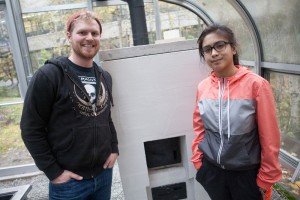
Canyon Lewis, on the left, and Jordan Batac pose for a photo by a masonry heater in a greenhouse behind the School of Engineering on the University of Alaska Anchorage campus in Anchorage, Alaska Thursday, Sept. 18, 2014. They will be part of team that continues work on this heater. (Photo by Philip Hall/University of Alaska Anchorage)
How did you get involved?
The International Arctic Social Sciences Association called for authors of chapters for the Arctic Human Development Report and I said I would like to work on education. They paired me with Andrey and we started collaborating mostly by Skype. And he said he was putting together this research network, would I like to be a part as an education person.
I really like the Arctic social science community. So much of the research here has focused on geological sciences and climate change and not as much of it has been on social sciences and the human dimensions. That group of people is just great.
Looking across the circumpolar north rather than looking south makes so much sense to me. Education policy decisions that have been made in Alaska based on what they are doing in Minnesota or Washington or some other state in the southern U.S. doesn't make as much sense to me.
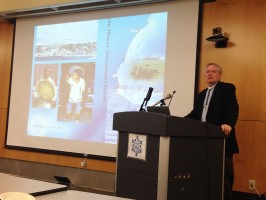
Lt. Governor Mead Treadwell attended the conferences and listened to advance reports from the Arctic Human Development Report II. Afterward, he addressed the conference and offered his insights about the value of social science in helping the Arctic and its peoples to flourish. (Photo by Diane Hirshberg/UAA)
Andrey and I spent time trying to understand what is happening in other circumpolar nations. It really reinforces that the issues are common, whether in Russia where they are struggling with small schools closing, or high teacher turnover rates in the northern Nordic countries, Or Sami people trying to figure out how to build a Sami educational institution but also have people be able to make the choices for non-Sami careers. Or Greenland where they have had an education system imposed on them by Denmark. Now they are trying to create their own, but they are dealing with a lot of the emotional and intellectual scars from colonization. All of that is relevant in Alaska.
How else is UAA engaged in Arctic social science?
Marie Lowe has organized an Arctic research faculty group and we have just started to meet.
But people like Matt Berman have been doing Arctic research for 30 years. You think of Vic Fischer who was working in Chukotka; we've had people doing Arctic research for 50 years.
Now I think there is a critical mass of younger faculty, particularly in the social sciences, moving into this area. There is a lot of excitement about how we build this here. The Chancellor is committing resources, supporting events like these conferences and designating Doug Causey to represent us with the University of the Arctic. UAA participation at the International Congress of Arctic Social Sciences conference in British Columbia was considerable and included students as well as faculty.
Now that I have stepped onto the International Arctic Social Sciences Association council I will be creating a strand for education. We probably will have easily 100 Arctic scholars participating as soon as I figure out the mechanism.
What draws you to the Arctic as a researcher and a scholar?
I realize people's views on race and ethnicity relate to policy in education. It is pretty clear when you have a state that has had the transition from BIA schools and boarding schools, and a state taking on providing education in indigenous communities as well as in urban communities, there are endless challenges to study.
Getting to look at this in the context of the Arctic has been so eye opening. What happened in Alaska and what is still happening in Alaska is not unique. The Arctic context changed everything.
When I got to Greenland I was invited to speak with one of the leaders of their post home rule education reform efforts. I suddenly saw an intellectual approach to indigenizing education that blew my mind. It has begun to really help me understand different models that could be applied in rural Alaska. The answer to rural Alaska's problems is not going to be a statewide teacher-mentoring program designed Outside. Some of what we are going to need to do in rural Alaska is emulate what is happening in other Arctic regions tackling these same issues.
What scares you about Arctic development, and what excites you about it?
There's two pieces about Arctic development that I think can be really scary. One is what happens to the physical environment if it is not done well. The threats to people's ways of life and to the physical environment are enormous.
The other threat is to people's wellbeing. We have seen it over and over again, whether it is Outsiders engaged in resource extraction industries who create havoc in the communities they go to. Or the havoc that happens to people themselves, when suddenly there is wealth and tradeoffs they have to make. When there are decisions to be made about what happens to their lands versus economics. Those are the scary pieces.
The exciting part is creating new opportunities for quality of life so that people can spend more time developing the arts and developing culture-thriving rather than surviving.
These are edited excerpts from an interview with Diane Hirshberg by Kathleen McCoy of UAA's Office of University Advancement.
 "Arctic social science: Q-and-A with Diane Hirshberg" is licensed under a Creative Commons Attribution-NonCommercial 4.0 International License.
"Arctic social science: Q-and-A with Diane Hirshberg" is licensed under a Creative Commons Attribution-NonCommercial 4.0 International License.














